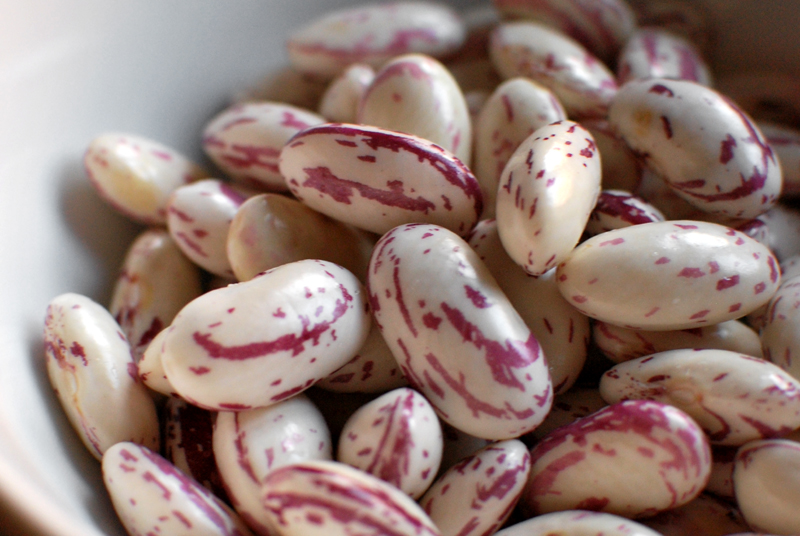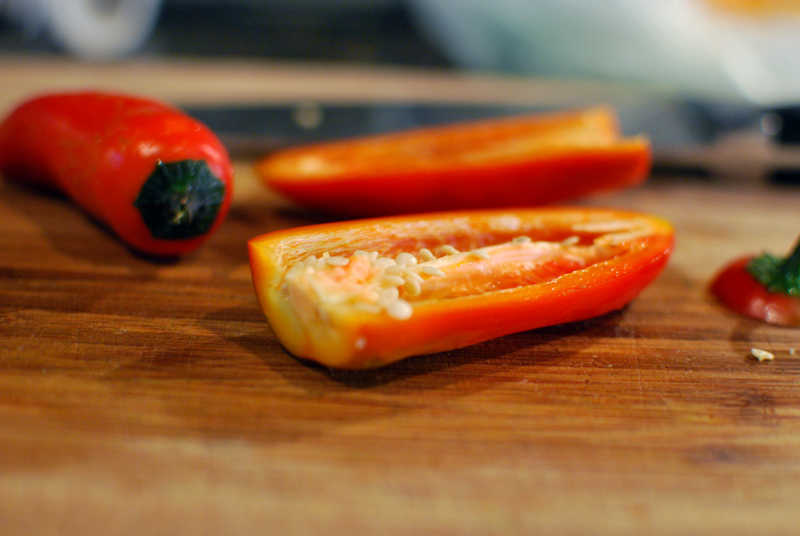As mentioned in my last post, I recently brought home a couple of pounds of fresh cranberry beans. But, having never prepared cranberry beans before (or any fresh beans, for that matter), I turned to my cookbooks and to the internets for help.
In looking through recipes, one in particular stood out like a sore thumb. From Dennis Cotter’s book Wild Garlic, Gooseberries, and Me came something (via 101 Cookbooks) that looked healthful, fresh, and completely unique: a baked cranberry bean and winter squash mole.
I’m familiar with mole sauces served with meat, or most commonly chicken; but I don’t think I’ve ever seen a mole with vegetables. And here, of all fantastic things to combine, were cranberry beans, winter squash, chilies, nuts, and chocolate.
Yes, please.
As luck would have it, I just so happened to have a small butternut squash sitting on my counter, though any similar winter squash would certainly work here. And just because I’m indulgent like that, and because I had some, I used a bit of rendered bacon fat to sauté the onion, celery, chilies, and garlic that became the base of the sauce. It lent a gorgeous hint of smoke to the robust dish, as did the spot of Bourbon I deglazed the pan with.
I didn’t have any of the 70% chocolate specified in the original recipe, but the block of unsweetened chocolate in my pantry seemed close enough. The resulting sauce was just a touch too bitter, too earthy for my tastes. A squeeze of honey, however, and the sauce snapped into harmonious balance.
My only problem with this dish is one that I commonly have: my understanding of the heat level of chilies and other spices can sometimes be off the mark. Way off. Yes, I thought the red jalapeños weren’t quite enough, so a rogue Aurora chili pepper got minced in as well. And then I decided to use the hot paprika instead of the sweet. And I tossed in a cavalier pinch of cayenne for good measure.
The result was a fantastically complex and building heat that might actually have been perfect, were it turned down about two notches. As it was, a small bowl of cooling yogurt was a necessary condiment to even make it through one plate. It was that spicy. I loved it.
But, being kind to the others in my household meant that the mole couldn’t be served in that form again. (The recipe has also been amended to give a more reasonable heat.) Leftover mole, then, was whizzed in the food processor into a sort of spicy, dark pesto that was simply outstanding on penne and gemelli pasta. Yogurt may have also been necessary here, for some; unnecessary though I found it, I used it all the same for the creaminess it gave the dish.
The truly remarkable thing about the dish was how long we ate at it before it disappeared. The original mole served three or four meals, and the resurrected “pesto” served at least six meals. It really was a loaves-and-fishes kind of situation.

In both iterations, though, the mole was hugely flavorful, bold and full of the rich tones achieved only through slow cooking. Chocolatey, too, but not in a saccharine brownie-fudge-cake way; only the deep savory notes shone through. The next day, it was even better after the flavors had properly melded (though still extremely spicy).
These fantastic dishes are part of the reason I love treating myself to new produce, to stepping outside of my culinary comfort zone from time to time. No, I’m probably not about to start making moles every night, or even cooking fresh beans every day; but now I understand them a little more, and I’ll probably jump at the chance to buy fresh beans whenever I see them in the store. My world is now a little bigger, a little more flavorful, a little more adventurous.
And all from a few simple beans.
Baked Cranberry Bean and Butternut Squash Mole
Makes between 4 and 5000 servings
Adapted from Wild Garlic, Gooseberries, and Me, by Dennis Cotter, via 101 Cookbooks
If you’re preparing the Basic Cooked Cranberry Beans (see below) for this recipe, you’ll have the white bits of the leeks left over. You should absolutely use those, washed well and chopped, in this sauce, either in lieu of or in addition to the onion. If you want to make the “pesto” with any leftovers, you may want to thin the purée with a bit of liquid, such as the water an accompanying pasta is cooked in.
1 small butternut squash (about 1 1/2 pounds), peeled, seeded, and chopped into 1/2 inch cubes
1 tablespoon olive oil
1 tablespoon rendered bacon fat (or butter, or olive oil)
1 medium onion, chopped
2 stalks celery, chopped
2 jalapeño peppers, preferably red, seeds removed, minced
4 cloves garlic, minced
1 splash Bourbon (or white wine)
1 tablespoon tomato paste
1 tablespoon sweet paprika
1 bay leaf
2 cups vegetable or chicken broth
1 1/2 ounces pecans, chopped finely or ground in a food processor
1 1/2 to 2 ounces unsweetened chocolate, chopped
1 tablespoon honey
1/2 recipe (about 8 ounces) Basic Cooked Cranberry Beans, recipe below (or 8 ounces canned cannellini beans)
Salt and pepper, as needed
Goat cheese, for serving (optional)
Chopped fresh parsley, for serving (optional)
1. Preheat oven to 400º F. Prepare the butternut squash. Toss the cubes with the olive oil, and season lightly with salt and pepper. Spread into a single layer, and roast for 15 minutes, or until softened and beginning to color. Remove from oven and let cool slightly. Reduce heat to 325º F.
2. While squash roasts, heat the bacon fat in a medium pan over medium-high heat. Add the onion and celery, and cook for 5 minutes, or until softened. Reduce heat to medium-low, add the jalapeños, and cook until lightly caramelized, 20 to 30 minutes, stirring often.
3. Add the minced garlic and cook until fragrant, 1 to 2 minutes. Increase heat to medium. Deglaze the pan with the Bourbon, scraping the pan to release any brown bits. Add the tomato paste, paprika, and bay leaf, stirring to combine. Sprinkle with a bit of salt and pepper. Add the broth, and bring to a simmer.
4. When broth is hot, add the ground pecans, chocolate, and honey, stirring until chocolate melts. Add the cooked beans and the roasted squash. Remove from heat. Taste, and correct seasoning as needed with salt, pepper, and honey.
5. Pour mole into a ceramic baking dish, and cover. Bake for about 1 1/2 hours. Let cool briefly before serving, with rice, polenta, tortillas, potatoes, or similar. Top with crumbled goat cheese and chopped fresh parsley, if desired. Yogurt is good on top as well.
Basic Cooked Cranberry Beans
Makes about 1 pound (or 3 cups) cooked beans
I don’t specify in this particular recipe what may be done with either the broth or the beans, but both are so flavorful that I don’t think you’ll have many problems finding uses. Use the broth in most places you would use chicken or vegetable stock (it will be rather cloudy); see above for a recipe for the beans.
5 or so stems fresh parsley
2 to 3 stalks fresh thyme
2 bay leaves
1/2 teaspoon whole black peppercorns
5 dried pequin peppers (optional, also may substitute other small dried chili peppers)
5 whole juniper berries (optional)
3 whole allspice berries
1 onion, peeled and quartered
2 stalks celery, chopped roughly
Green tops from 1 bunch leeks (save whites for another use), washed well
2 pounds fresh cranberry beans in pods, shelled and rinsed
1. In a triple-thick layer of cheesecloth, tie up the parsley, thyme, bay leaves, peppercorns, peppers, juniper, and allspice into a bouquet garni. Twine may be used, or simply tie the corners of the cheesecloth together.
2. Place bouquet garni and all remaining ingredients into a 5 to 6 quart pot, and cover with cold water. Bring just to the boiling point over high or medium-high heat, then reduce heat to maintain a simmer, over medium-low or low.
3. Simmer uncovered for about 15 minutes, or until beans are fully cooked. If unsure, cut a bean in half. If the center looks chalky and white, continue cooking another 5 minutes or so, until beans are done.
4. Using a strainer, lift out leek tops, onion, celery, and bouquet garni. Discard. Strain beans from broth with either a colander or strainer, reserving both.




